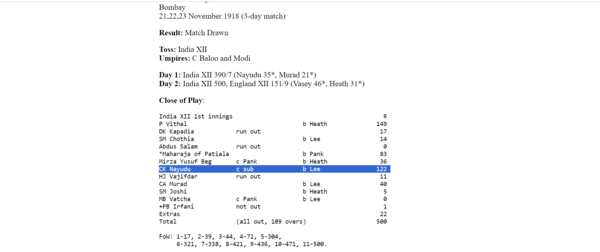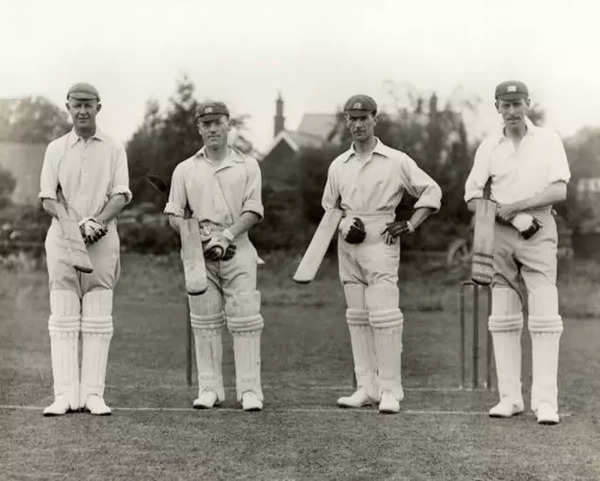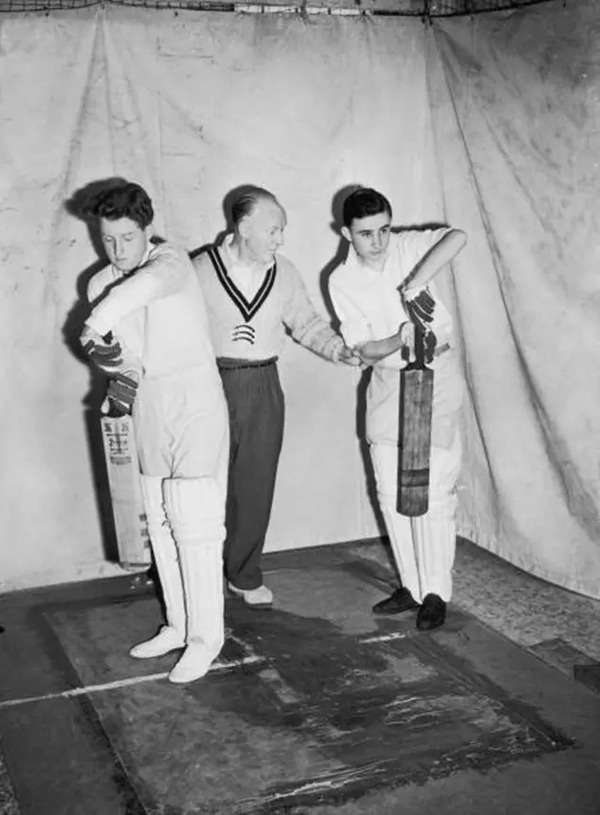But, have you ever heard of a cricketer who played a Test match 15 years after his “death”? Chances are that you haven’t.
The year was 1915. World War I, or The Great War, was taking a huge toll on Europe. Great Britain had already been raided and bombed by Zeppelins (as the German airships were known), in January 1915. German troops had captured Warsaw from the Russians. Hundreds and thousands of people were dying every day, including many cricketers, and Europe was devastated. Wisden Almanack’s obituary section in 1915 filled 77 pages, the list included names of two greats of the game — W G Grace and Victor Trumper — although they didn’t die in the war.
Not interested in the military services, Harry Lee was busy with his cricket when the war broke out. In fact, his maiden century for Middlesex came just days after the war began, against Nottinghamshire in August 1914, as he scored 139 runs at Lord’s Cricket Ground.
Born on October 26, 1890, Harry Lee was the eldest among the ‘Lees of Marylebone,’ as three cricket-playing brothers were known. Initially, he worked with his father as a greengrocer but later decided to pursue a different path. At the age of 15, he wrote to the MCC seeking a job on the ground staff at Lord’s Cricket Ground. After three years, he earned a place in the Middlesex Colts (U9 – U18), and after two more years, he made it onto the first team in 1911. Although, he wasn’t a regular fixture for Middlesex until 1914.
After the war broke out in August 1914, Britain asked its young male citizens to voluntarily join the army. “It is far better to face the bullets than to be killed at home by a bomb, join the army at once, and help to stop an air raid. God save the King,” read a poster issued by the UK government. Almost 7.5 lakh citizens joined the British Army, just within eight weeks after the war began. When British Territorial Forces marched through London, Lee, who was initially reluctant to join the war effort, decided to join the Army in September 1914.

Harry Lee was initially enlisted into the 13th Battalion, part of the London regiment. The battalion was usually known as “The Kensingstons”, as it recruited a significant number of personnel from that area of London. After going through training for a few months, Lee, on February 25, 1915, was posted to the 1/13th Battalion, which consisted of men who had volunteered for overseas service. Just over a week later, Lee was in France where he took part in the Battle of Neuve-Chapelle (10–13 March 1915). The Battle was an Allied offensive, aimed to regain the French village of Neuve-Chapelle from German forces, and they were successful in their effort.
Predicting another attack, the Germans prepared well and fortified the area. The Battle of Aubers Ridge began on May 9, and Kensingtons were one of those to lead the attack from the northern pincer. The British Army successfully struck some initial blows, but they came at a very heavy price as the number of casualties crossed 11,000 on the very first day.
Of the 550 Kensington men involved in the battle, 499 lost their lives. Harry Lee was one of them, it was presumed. After his body was not found, the news about his death spread and reached his household. Lee’s parents held his memorial after his death was announced.
But Lee, quite miraculously, was alive. The news of his death was not true. “I’m glad to say this was premature,” Lee later wrote in his autobiography. Although he was shot in his left thigh during the battle and the bullet fractured his femur or thigh bone, he didn’t die. He lay in no man’s land, unconsciously, for three days, before German forces found and transported him to a hospital in Valenciennes, France. The ten-hour journey, before he was shifted to a French Red Cross train in Lille, was terrible. Lee was put into a cattle train with other wounded soldiers, lay on sacks of straw, and provided with a single bucket to be used as a common toilet for all.
Lee had stayed at Valenciennes for almost six weeks before he was transferred to Hannover, Germany, and was handed over to the German Red Cross. At Hannover, Lee’s wounds had been healing but he, on the advice of a fellow war prisoner, decided to exaggerate his injury and asked for permission to return home. Permission was granted and Harry Lee began his journey to England on October 1, 1915.
Lee must have been rejoiced by the prospect of going back home and being reunited with his family, but sorrow followed him. When he was receiving treatment in England, doctors told him that he had suffered considerable muscle death, and his one leg would be permanently shorter than the other one.
Harry was discharged from the Army in December 1915, and was honoured with the British War Medal, 1914-15 Star, Silver War Badge, and Victory Medal.
As he was discharged, doctors told him that he could neither join the Army nor play cricket.
Life after ‘death’ and Lee’s ‘excursion to India’
After he was discharged from the Army hospital, Middlesex took care of him, and Lee was provided with a specialist for the treatment. Out of the Army, Lee worked as a filing clerk in the War office.
But what about cricket? Well, he played it again. What else can you expect from a man who was resolute enough to defy death? Won’t he play the game that was so close to his heart? In early 1916 he played a match for Royal Army Service Corps and scored a century against Lancing College, and played some more matches for the MCC here and there.
By the end of summer of 1916, Harry Lee was suggested by the wife of Frank Tarrant, his Middlesex colleague who had got the job in India, to accompany Tarrant in Calcutta.
Frank Tarrant was an Australian-English cricketer who later served as a cricket aide to the Maharajas of Patiala and Cooch Behar. “A canny adviser and an astute lobbyist with impeccable connections, Tarrant helped lay the foundations of Indian cricket,” writes Mike Coward in Tarrant’s biography ‘Cricket’s Forgotten Pioneer: The Frank Tarrant Story‘. Tarrant also holds the record for the first man to take all ten wickets in an innings in a first-class match in India.
So Harry Lee accepted the offer of Tarrant’s wife but it would take one more year for Lee to embark on his journey to India as he lost his mother. A year later, he decided to come to India. Initially, he was to board Nyanza to Bombay. But, at the last minute, he was transferred to Nagoya which was directly heading to Calcutta. It turned out that Lee had dodged death yet again as Nyanza was torpedoed about 20 miles after it set sail and 49 lives were lost.
In India, Lee worked as football and cricket coach to the Maharaja of Cooch Behar. “Whatever you do, don’t get the Maharajah out for a duck. He doesn’t like it,” Lee would later write in his autobiography called Forty Years of English Cricket with excursions to India and South Africa.
Lee also made his comeback to first-class cricket in India in March 1918, playing for Maharaja of Cooch Behar XI against Lord Willingdon’s XI, named after then Viceroy to India. Lee took 5 wickets for 11 runs, and 3 wickets for 41 runs in both the innings, respectively. Although Willingdon’s XI won the match by 1 wicket.
In November 1918, Lee played for an “England XII” side against “India XII” side in a three-day 12-a-side match in Bombay. “India XII” chose to bat first and scored 500 runs in the first innings. Lee took 4 wickets while conceding 177 runs in 32 overs, which he bowled in a single spell. England barely saved the match by 1 wicket as the match was drawn.
In India’s first innings, a certain Major CK Nayudu, whom Lee described as a “very fine bat”, passed his previous highest score of 80 in First-Class matches and scored 122 runs. 12 years later, in 1932, Nayudu would captain India in their first ever Test match against England at Lord’s.

Lee’s Homecoming
As County cricket resumed in 1919 after the war, Lee came back to England and continued to play for Middlesex despite the injury. In the season of 1919, Harry Lee scored 1,223 runs in 19 matches at an average of 40.76. His highest score of the season was 163. He also got 52 wickets.
In the title-winning season of 1920, Lee smashed 1,518 runs at 43.37 in just 23 matches for Middlesex. He scored 5 centuries and 4 half-centuries in the season, and his highest score was 221 runs in a 9-wicket win against Hampshire.

Out of 16 seasons of first-class cricket Lee played after the war (1919-1934), he crossed the 1000-run mark in 13 of them. While Lee never quite reached the milestone of 100 wickets in a single season, he came close in 1921 when he took 72 wickets at an average of 19.67. His performance was crucial in Middlesex winning the championship title for the second year in a row.
Tryst with the Test
In the 1920s, Lee usually used to spend the winters in South Africa by coaching and playing cricket in the country. While Lee kept playing for Middlesex in the summers, he coached St Andrews College (Grahamstown), South African College School (Cape Town), and St Andrews School and Greys College (Bloemfontein) in the winters.
Aged 40, Lee was in the twilight of his career in 1931 when he got work at St Andrew’s College and Rhodes University in Grahamstown, South Africa. An England side led by Percy Chapman was also touring South Africa at the same time. Chapman’s side was heavily hit by injuries, losing seven players at different stages during the tour. Lee was called as a replacement and in his first five innings of tour matches, he crossed double figures.
After 3 Tests, England were down 0-1 in the series when Harry Lee finally got the Test cap in the fourth Test at Johannesburg on February 13, 1931, fifteen years after his “death”. Lee opened with the bat and scored 18 and 1 in both the innings of the match, which ended in a draw.
Despite playing the Test, Lee didn’t receive his Test cap. Why? During the match, Lee found himself in a dispute with one of the schools he had been coaching at. The school had lodged a complaint with MCC saying that Lee had violated his contract by leaving without their permission.
Feeling that an apology was unnecessary, Lee never received the cap or blazer from the MCC. However, he did receive a small consolation in the form of an England touring tie, which was given to him by Jack Hobbs. Lee never got the chance to play a Test match again.
Post-retirement life
Harry Lee played until the age of 43, scoring 20,158 runs at an average of 29.95. He scored 38 centuries while batting at various positions, relying heavily on his exceptional leg-side stroke play.
In addition to his batting prowess, Lee was also a skilled bowler. He claimed 401 wickets from 437 matches at an average of 30.61, including 12 five-wicket hauls and 3 ten-wicket hauls.
Throughout his career with Middlesex, Lee amassed 18,594 runs and took 340 wickets, becoming one of only nine players to achieve the feat of scoring 10,000 runs and taking 300 wickets for the county.
Despite his age, Lee was disappointed when Middlesex decided not to renew his contract after the 1934 season. Following this, he immediately transitioned into umpiring, a role he held until 1946. He then started coaching at Downside School in Somerset, where he remained until his retirement in 1953.
In 1948, two years after retiring as a First-Class umpire, Lee’s autobiography co-authored by Laurence Thompson, ‘Forty Years of English Cricket with excursions to India and South Africa,’ was published.

In his later years, Lee was a regular presence in the Mound Stand at Lord’s during matches.
Harry Lee passed away on April 21, 1980, at the age of 90 in Middlesex Hospital. At the time of his death, he was the second-oldest surviving English cricketer, after Andrew Sandham.
